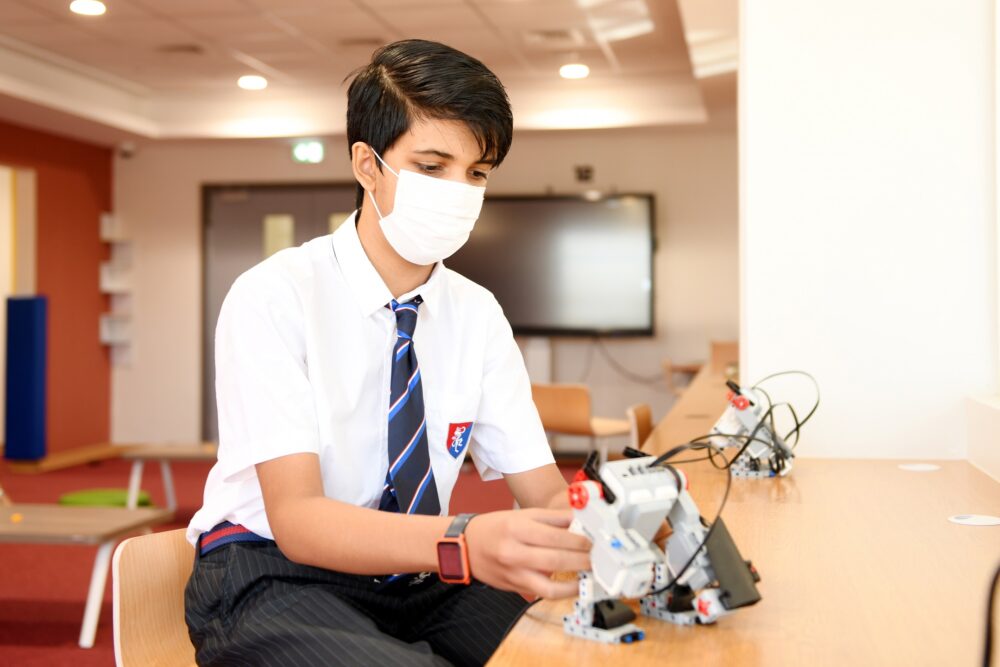Robotics education and its integration into mainstream curriculum has gained significant momentum across UAE schools, especially after the reintroduction of in-person classes
Dubai, March 14, 2022: The return to in-school education after several phases of remote or hybrid learning has given a new momentum to robotics education.
More schools are lining up to either introduce robotics or advance to a higher level of integration into their curriculum.
Suppliers and edtech firms delivering customised STEAM programmes are also seeing an upsurge in demand.
As per latest reports by Grand View Research, Inc, the global educational robotics market is expected to grow at 19.8 per cent annually to reach $3.27 billion by 2028. GCC contributes close to 2-3% of the estimated global educational robot market and continues to grow at a similar pace. “The primary education sector holds a large slice of the pie and is expected to grow at a much faster rate,” says Tanmay Sankhe, Dept Head – Robotics Education, Emerging Stars Learning Center LLC.

As per Maloy Burman, CEO, Premier Genie, the robotics education market in the UAE is quite big, with robotics labs functioning in 100 plus schools and more than 100,000 students involved in STEM education.
Prior to the pandemic most robotic learning was centred around labs and devices shared among students at school. However, with schools embracing study from home models, STEM providers started adapting to the new reality by developing personal kits.

The beginning of the pandemic however, brought robotic education almost to a halt. Jacob de Leeuw, Academic and Innovation Coordinator, Swiss International Scientific School says, “We had to ensure uncontaminated devices. If devices would be allowed to go home, they would have to be sanitised and quarantined for an extended period of time.”
Kits also couldn’t be sent home simply because of the nature of transport and contact. Steve Kay, Wellington Group Director of STEM and Primary Assistant Principal at GEMS Wellington Academy – Al Khail says once the equipment left the premises it was near to impossible for schools to guarantee the safety in terms of contamination and other factors.

Many schools had stopped delivering robotics as part of the curriculum following the restrictions imposed at the beginning of the pandemic, as Farida Dhambolawala, CEO & Founder, Innovo8Tech points out. “However, some schools who had budgets deployed an Own Your Own Robot (OYOR) initiative, which allowed students the opportunity to continue robotics despite having online learning,” says Dhambolawala.
According to her, the majority of schools didn’t have budgets or they were withdrawn due to parents removing their children from school or requesting fee reductions. “The uncertainty of the situation meant everyone needed to spend wisely,” she says, adding that her company immediately changed strategy to adapt to the new reality.
“We changed our business model fairly quick and focused on a B2C model rather than a B2B,” she says. Parents who withdrew their children, according to her, were more open to enrolling them into online courses and purchasing OYOR kits. “We also launched a subscription pack with different robotic kits being sent out each month, allowing children to remain focused and feeling enthusiastic.”
Some schools also recommended kits that parents could buy, from simple robotic Lego to more complicated control systems.
It was beneficial for both schools as well as suppliers who wanted to focus more on individual students.

As Sankhe says, “The cost of establishing a robot-based education centre may be expensive for many schools. Investment in manpower, curriculum developer and robot hardware are essential parameters required to introduce robotics education in any school.”
According to him, one way to overcome the problem is “to offset the CAPEX to learning centres like us or tie up with robot manufacturers who will manage the initial investment on revenue sharing model.”
In the meantime, schools who had robotics as part of their curriculum resorted to online tools, coding apps and a slight change in focus when they switched to remote learning.

“In primary classes, the distance learning course began with practical ‘Get Ready for Programming’ lessons about the principles of computational thinking and the basics of programming, using Online Bee-Bots, Scratch-Junior and Logo programming which were all possible online,” confesses Simimol Jacob, ICT and Computing Teacher, RIS Primary School.
Many schools changed their focus to coding. “The fundamentals of robotics – coding, problem solving and designing systems – were able to continue via coding apps that were available to our children,” says Kay.
According to him, the vast range of free-to-use coding apps also mimic the processes of robotics, whereby children were able to engage and gather some similar skill sets, “although the awe and wonder of the physicality of using robotics was obviously lost and something that children couldn’t recreate at home,” he notes.
The pandemic made them think strategically about how to continue with robotics, says de Leeuw. “A large part of the school’s robotics programme was coding and programme development of robots. As restrictions were lifted, we were able to utilise robotics. However, following sanitisation protocols and giving students specific devices to work with allowed us to ensure that teaching of robotics continued while still remaining safe,” he adds.
It was not all easy for teachers as well. Teaching robotics was difficult from a distance learning point of view. “Since lessons were being conducted online, having concrete resources in hand was challenging. Utilising simulations and gamification supported instructors to still have students being engaged in the content and concepts being covered,” says de Leeuw.

“The obvious challenge was to find ways of engaging all the senses to help in cognitive and physical development, which was difficult at home via digital apps,” says Kay adding that allowing children to physically manipulate and use a wide range of resources, which target all the senses is a key aspect of developmental growth particularly down in FS and KS1. “So getting the children back on site with technology in their hands was one of the challenges that we faced.”
According to him, while the usefulness and importance of robotics has not changed post-pandemic, what has changed is a deeper understanding and acceptance of the ability for robotics to drive the wonder of learning that stagnated somewhat during remote learning.
More and more schools are recognising not just the academic benefits of working with robots but the benefits of taking children out of the everyday classroom environment into laboratories and STEAM labs where they can develop a wider range of skills including collaboration and problem solving, say educators. “Even our youngest students can develop their cognitive abilities at a much quicker pace when they are working with robots as the interconnected nature of learning drives their development,” admits Kay..

Saba Adnan, Director of Innovation and Technology, GEMS Founders School – Al Mizhar says that in the grand scheme of things, it is also about the global acceptance for new ways of thinking, learning and working. “This major shift in thinking has influenced the approach towards robotics as well. It is no longer considered an option or a set career path but an integrated knowledge and skill component for any career and field of life.”
As Matthew Backus, IT Teacher/Integrator, Dunecrest American School puts it. “One of the biggest concepts I try to educate my students on is the importance of the human brain behind robotics. Robots are only as smart

and versatile as the code they are running on. But what cannot be done by robots is knowing how to design, code and maintain themselves. This is where the human workforce is still going to be in high demand.”
(With inputs from Ritika)








